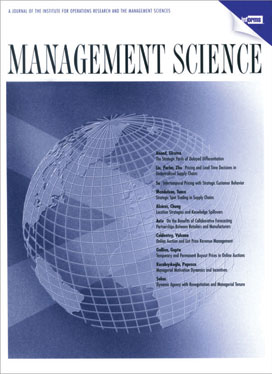Academic articles
Practitioner articles
Working papers
Books
Book chapters
Case studies
Other publications
Subject(s)
Marketing
Keyword(s)
Product development, marketing strategy, durable goods, quality, signaling game
Our objective is to understand how a firm’s product development capability (PDC) affects the launch strategy for a durable product that is sequentially improved over time in a market where consumers have heterogeneous valuations for quality. We show that the launch strategy of firms is affected by the degree to which consumers think ahead. However, only the strategy of firms with high PDC is affected by the observability of quality. When consumers are myopic and quality is observable, both high and low PDC firms use price skimming and restrict sales of the first generation to consumers with high willingness to pay (WTP). A high PDC firm, however, sells the second generation broadly while a low PDC firm only sells the second generation to consumers with low WTP. When consumers are myopic and quality is unobservable, a firm with high PDC signals its quality by offering a low price for the first generation, which results in broad selling. The price of the second generation is set such that only high WTP consumers buy. A firm with low PDC will not mimic this strategy. If a low PDC firm sells the first generation broadly, it cannot discriminate between the high and low WTP consumers. When consumers are forward looking, a firm with high PDC sells the first generation broadly. This mitigates the “Coase problem” created by consumers thinking ahead. It then sells the second generation product only to the high WTP consumers. In contrast, a firm with low PDC does the opposite. It only sells the first generation to high WTP consumers and the second generation broadly.
View all ESMT Working Papers in the ESMT Working Paper Series here. ESMT Working Papers are also available via RePEc, EconStor, and the German National Library (DNB).
Pages
40
ISSN (Print)
1866–3494
Subject(s)
Human resources management/organizational behavior
Keyword(s)
competencies, personality traits, organizational rewards, motives, socioanalytic theory, middle managers
Volume
26
Journal Pages
66–92
Subject(s)
Strategy and general management
Keyword(s)
decision-making uncertainty, industrial market offerings, complex solutions, typology
Customer decision-making uncertainty (DMU) is a persistent phenomenon in
business-to-business markets. However, there is substantial variation in the
degree customers perceive DMU and hence suppliers should react to it. Based
on existing industrial buying typologies, this paper proposes a new classification
scheme to explain variance in customer DMU. To this end, market offering
complexity and co-creation are used as defining dimensions and four ideal types
of industrial market offerings are constructed. We show theoretically that DMU is
especially prevalent for complex solutions. The paper closes with guidance for
suppliers of industrial market offerings and an outlook for future research.
With permission of Emerald
Volume
25
Journal Pages
65–85
Subject(s)
Management sciences, decision sciences and quantitative methods
Keyword(s)
service operations, queueing theory, dynamic programming, decision making, information search, Bayes' rule
In diagnostic services, agents typically need to weigh the benefit of running an additional test and improving the accuracy of diagnosis against the cost of delaying the provision of services to others. Our paper analyzes how to dynamically manage this accuracy/congestion trade-off. To that end, we study an elementary congested system facing an arriving stream of customers. The diagnostic process consists of a search problem in which the service provider conducts a sequence of imperfect tests to determine the customer's type. We find that the agent should continue to perform the diagnosis as long as her current belief that the customer is of a given type falls into an interval that depends on the congestion level as well as the number of performed tests thus far. This search interval should shrink as congestion intensifies and as the number of performed tests increases if additional conditions hold. Our study reveals that, contrary to diagnostic services without congestion, the base rate (i.e., the prior probability of the customer type) has an effect on the agent's search strategy. In particular, the optimal search interval shrinks when customer types are more ambiguous a priori, i.e., as the base rate approaches the value at which the agent is indifferent between types. Finally, because of congestion effects, the agent should sometimes diagnose the customer as being of a given type, even if test results indicate otherwise. All these insights disappear in the absence of congestion.
© 2013 INFORMS
This publication was a finalist of the 2016 Service SIG Best Paper Competition.
This publication was a finalist of the 2016 Service SIG Best Paper Competition.
Volume
59
Journal Pages
157–171
ISSN (Online)
1526-5501
ISSN (Print)
0025–1909
Subject(s)
Economics, politics and business environment
Keyword(s)
competition policy, regional state aid, subsidies, anti-competitive effects
JEL Code(s)
H81, L4, O25, R58
Journal Pages
46–60
Subject(s)
Management sciences, decision sciences and quantitative methods
Keyword(s)
newsvendor, risk aversion, gender difference, behavioral operations
We present results from two experiments that reveal significant gender differences in ordering behavior in the newsvendor problem. In high margin settings, males tend to order more than females, and they also tend to achieve higher profits. There are no gender differences in low margin settings. We show that the observed gender differences are partially driven by (or mediated by) gender differences in risk appetite. Males tend to prefer taking greater risk than women, and this leads them to order more in the newsvendor problem (in high margin settings). We show that the risk-ordering relationship is related to financial risk attitudes but not to social risk attitudes, and also that the effect is not driven by gender differences in affect, a likely alternative explanation for the results.
With permission of Elsevier
Volume
31
Journal Pages
86–92
Subject(s)
Ethics and social responsibility; Strategy and general management
Secondary Title
Sustainability Management: Nachhaltige und stakeholderorientierte Wertsteigerung
Pages
231–256
ISBN
978-3-8325-3286-4
Subject(s)
Information technology and systems
Keyword(s)
Communications technology, information systems, organizations, systems engineering
Argues that, despite their large investments in data scientists, and IT tools, many companies are struggling to capitalize on the massive amounts of data now available to them. Suggests that most managers are employing the conventional approach to designing and installing IT systems and this approach may not be appropriate for exploiting the tremendous amounts of data now available from internal and external sources. Notes that a big data or analytics project is likely to be smaller and shorter than a conventional IT initiative, such as installing an enterprise resource planning (ERP) system. Identifies five guidelines for taking an alternative approach to IT systems development: place people who will create meaning from the information at the heart of the initiative; unlock value from IT by asking second-order questions and giving teams the freedom to reframe business problems; equip teams with cognitive and behavioural scientists, who understand how people perceive problems and analyse data.; focus on learning by facilitating information sharing, examining assumptions, and striving to understand cause and effect; and worry more about solving business problems than about deploying technology.
Volume
91
Journal Pages
104–111
ISSN (Print)
0017-8012
Subject(s)
Entrepreneurship
Keyword(s)
entrepreneurship, business planning, personal characteristics
In July 2010, André Glardon, who is the regional sales director of a major health care products provider in Spain, returns from an unpleasant customer visit. The head of administration to the Hospital de Gandía, one of his important customers, just delayed the order of two MRIs, making it almost impossible for André to reach his personal annual sales targets. External factors such as the health care reforms, the exploding costs of the health care system, a shift in the buying behavior of hospitals and increased economic pressures on hospitals, might be causing a fundamental shift in the industry. Through the implementation of new business models that address these issues. André and two friends developed a business idea and were wondering whether they should push this idea within their company or leave their company and launch the business on their own.
| buy now | buy now | buy now |
Subject(s)
Ethics and social responsibility; Marketing
Keyword(s)
corporate ethics, consumer meanings, corporate social responsibility (CSR), consumer perceived ethicality (CPE), brand perceptions, construct conceptualization, scale development
Volume
111
Journal Pages
551–565


